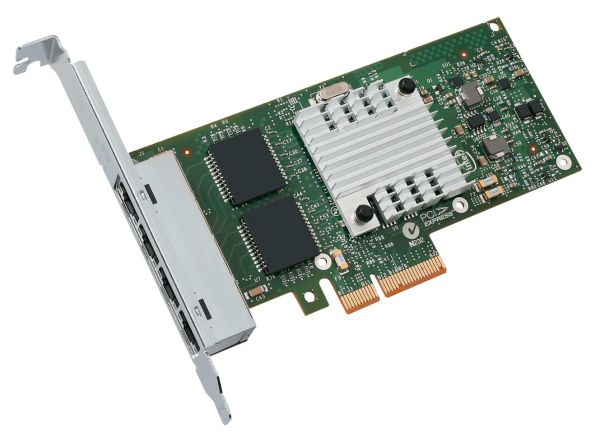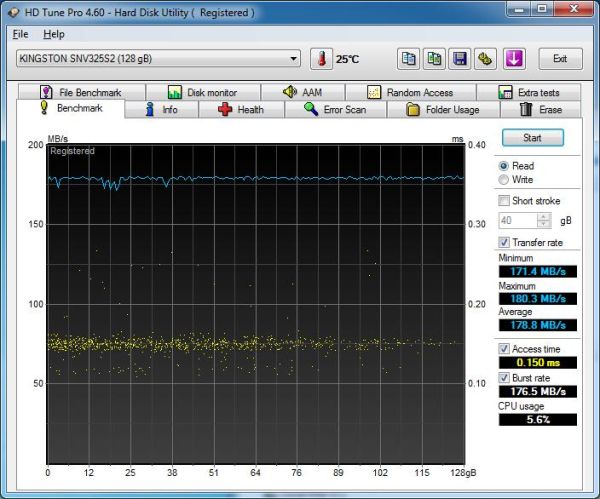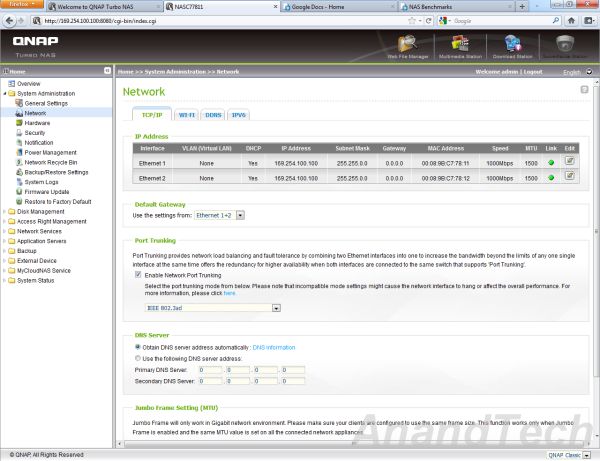QNAP TS-659 Pro II Review
by Ganesh T S on September 19, 2011 8:00 AM EST- Posted in
- IT Computing
- NAS
- QNAP
For the purpose of NAS reviews, we have setup a dedicated testbed with the configuration as below. The NAS is directly connected to the testbed (using as many Cat 5E cables as there are ports on the NAS) without a switch or router inbetween. This is done in order to minimize the number of external factors which might influence the performance of the system.
| NAS Benchmarking Testbed Setup | |
| Processor | Intel i5-680 CPU - 3.60GHz, 4MB Cache |
| Motherboard | Asus P7H55D-M EVO |
| OS Hard Drive | Seagate Barracuda XT 2 TB |
| Secondary Drive | Kingston SSDNow 128GB |
| Memory | G.SKILL ECO Series 2GB (1 x 2GB) SDRAM DDR3 1333 (PC3 10666) F3-10666CL7D-4GBECO CAS 7-7-7-21 |
| PCI-E Slot | Quad-Port GbE Intel ESA-I340 |
| Optical Drives | ASUS 8X Blu-ray Drive Model BC-08B1ST |
| Case | Antec VERIS Fusion Remote Max |
| Power Supply | Antec TruePower New TP-550 550W |
| Operating System | Windows 7 Ultimate x64 |
| . | |
In addition to the Realtek GbE NIC on-board the Asus P7H55D-M EVO, four more GbE ports are enabled on the system, thanks to the Intel ESA-I340 quad port GbE ethernet server adapter . With a PCI-E x4 connector, the card was plugged into the PCI-E x16 slot on the Asus motherboard.
Two of the four ports are teamed together as shown in the video below below during the benchmarking.
Intel NASPT is used to benchmark the NAS device. In order to ensure that the hard disk transfer rate is not a bottleneck, NASPT is run from the secondary drive in the testbed (the Kingston SSD). With average read and write speeds of 178.8 MB/s and 167.8 MB/s, it is unlikely that a single GbE link NAS can be limited in performance due to the test system. However, a link aggregated NAS could be affected. Fortunately, as we will see in the next few sections, this wasn't the case for the TS-659 Pro II.
All file copy tests were also performed using the SSD. The file copy test consists of transferring a 10.7 GB Blu-Ray folder structure between the NAS and the testbed using the robocopy command in mirror mode.
There are three important sharing protocols we investigated in the course of our evaluation of the TS-659 Pro II. In the next few sections, you will find NASPT / robocopy benchmarking results for Samba, NFS and iSCSI sharing protocols. Each section also has a small description of how the shares were set up on the NAS. The NASPT benchmarks were run in Batch mode thrice, giving us 15 distinct data points. The average of these 15 values is recorded in the graphs presented in the following sections. The robocopy benchmark was run thrice, and the average transfer rate of the three iterations is presented alongside the NASPT benchmarks.
The TS-659 Pro II supports multiple RAID configurations, but we believe that most of the users will end up running this in RAID-5. So, all our benchmarks are collected with the disks configured in a RAID-5 volume. The GbE ports were configured for dynamic link aggregation (802.3ad) as shown below:
Note that the 6 x 1 TB disks result in a total available space of arund 4600 GiB (shows up as GB on the NAS configuration webpage) when configured in RAID-5. This is due to a couple of maintenance partitions created by the QNAP firmware. Each 1 TB disk is partitioned as below.















69 Comments
View All Comments
Sivar - Tuesday, September 20, 2011 - link
This is always a good point to bring up. The mantra on StorageReview.com has long been, "RAID is for uptime. Backups are for disaster recovery."Visual - Monday, September 19, 2011 - link
How quiet is this thing?The only reason I would go for something like this is if it is really quieter than any file server I can build myself. It will need to be literally inaudible running 24/7 in my living room or else it will annoy me to hell some night when I decide to sleep on the sofa.
And what are the chances for mods adding torrent clients, web/db server and other gizmos to the OS without complete wipe, keeping the current admin interface for the RAID itself?
ganeshts - Monday, September 19, 2011 - link
Very quiet during periods of sporadic data access. But, putting it through the NASPT benchmarks would cause it to whirr up and create a ruckus of sorts for some time (Around 2 - 3 minutes) before going back to the quiet period again. This would would repeat every 5 minutes or so. This is what one expects when there are 3 fans in the system in such a small enclosure.Final word on noise: If you are sensitive to it, don't buy it.. I think the main target of this system is at enterprise and SMB/SOHO users who don't care about noise / keep the NAS in a server room.
bobbozzo - Tuesday, September 20, 2011 - link
At least some of their models seem to support bittorrent:http://www.qnap.com/faq_detail.asp?faq_id=547
chris1317 - Monday, September 19, 2011 - link
Thanks for the review. I have been using a QNAP 509 Pro for a few years now and it is a great performer. I have been looking for an upgrade though.It would be good if you could get a hold of the newly released models TS-879 or TS-1079. They support 10 GbE which I am really interested in.
Also its worth pointing out about the limitations of raid5 with regard to the unrecoverable read error during rebuild that can present itself and result in a loss of data http://www.zdnet.com/blog/storage/why-raid-5-stops... which is why I want to go for a larger model. Allthough these models support raid 6 its tough to sacrafice 2 drives out 6 (5 in my case) for parity.
DanNeely - Monday, September 19, 2011 - link
With the $1k price premium (859 vs 879), several hundred dollars/computer for 10GB cards, and >$10k price for a 10GB router; I'm not sure if 10GB hardware really qualifies for the small office yet.chris1317 - Monday, September 19, 2011 - link
lol, its for my house :) I like my gadgets, I do worry about the URE problem though.DanNeely - Monday, September 19, 2011 - link
URE?chris1317 - Monday, September 19, 2011 - link
URE (unrecoverable read error) from the article that I linked to in my first post. With drive size increasing there is going to become increasingly likely that when a drive fails and a rebuild is in progress that a seccond drive will experience an unrecoverable read error bricking the raid. The article points out that a 7 drive RAID 5 with 1 TB disks has a 50% chance of a rebuild failure due to ure with a standard 10-14 manufacturer spec for failure. Higher spec drives are available and Raid 6 helps with this as it has a 2 drive redundancy.Spazweasel - Monday, September 19, 2011 - link
Very true about reconstruction issues. RAID rebuilding hammers a drive like little else can.Fortunately, the reviewed NAS supports RAID6, as well as RAID5 + hot spare and RAID6 + hot spare.